King's College Chapel, Cambridge
King's College Chapel is the chapel of King's College in the University of Cambridge. It is considered one of the finest examples of late Perpendicular Gothic English architecture.[3] The Chapel was built in phases by a succession of kings of England from 1446 to 1515, a period which spanned the Wars of the Roses and three subsequent decades. The Chapel's large stained glass windows were not completed until 1531, and its early Renaissance rood screen was erected in 1532–36. The Chapel is an active house of worship, and home of the King's College Choir. The Chapel is a significant landmark and a commonly used symbol of the city of Cambridge.[4][5]
| King's College Chapel | |
|---|---|
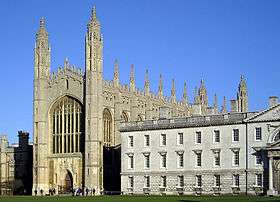 King's College Chapel (partially obscured by the Gibbs' Building), seen from The Backs. | |
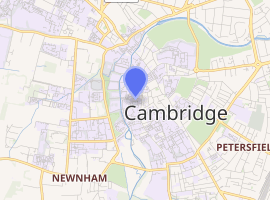
| |
| 52.2048°N 0.1165°E | |
| Location | Cambridge |
| Country | United Kingdom |
| Denomination | Church of England |
| Previous denomination | Roman Catholic |
| History | |
| Status | Collegiate chapel |
| Dedication | Our Lady and Saint Nicholas |
| Consecrated | 1443 |
| Architecture | |
| Functional status | Active |
| Heritage designation | Grade I listed |
| Designated | 26 April 1950[1] |
| Architect(s) | Disputed |
| Architectural type | Church |
| Style | English Gothic |
| Years built | 1446–1515 |
| Specifications | |
| Length | 289 feet (88 m)[2] |
| Width | Vault: 40 feet (12 m)[2] |
| Height | Interior: 80 feet (24 m) Exterior: 94 feet (29 m)[2] |
| Number of spires | 4 |
| Clergy | |
| Dean | Revd Dr Stephen Cherry |
| Laity | |
| Organist/Director of music | Daniel Hyde |
| Music group(s) | King's College Choir |
Construction
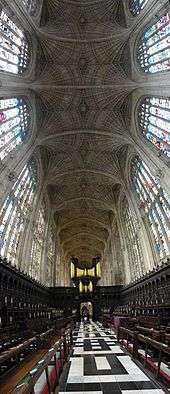
Henry VI planned a university counterpart to Eton College (whose Chapel is very similar, but not on the scale intended by Henry). The King decided the dimensions of the Chapel. Reginald Ely was most likely the architect and worked on the site since 1446.[6] Two years earlier Reginald was charged with sourcing craftsmen for the Chapel's construction.[6] He continued to work on the site until building was interrupted in 1461, having probably designed the elevations.[6] The original plans called for lierne vaulting, and the piers of the choir were built to conform with them.[6] Ultimately, a complex fan vault was constructed instead.[6] Reginald probably designed the window tracery at the extreme east of the church's north side: the east window of the easternmost side chapel, which unlike the Perpendicular style of the others is in curvilinear Gothic style.[6] The priest and later bishop Nicholas Close (or Cloos) was recorded as the "surveyor", having been the curate of St John Zachary, a church demolished to make way for the Chapel.[7][8][9]
The first stone of the Chapel was laid, by Henry himself, on the Feast of St James the Apostle, 25 July 1446, the College having been begun in 1441. By the end of the reign of Richard III (1485), despite the Wars of the Roses, five bays had been completed and a timber roof erected. Henry VII visited in 1506, paying for the work to resume and even leaving money so that the work could continue after his death. In 1515, under Henry VIII, the building was complete but the great windows had yet to be made.
The Chapel features the world's largest fan vault, constructed between 1512 and 1515 by master mason John Wastell. It also features fine medieval stained glass and, above the altar, The Adoration of the Magi by Rubens, painted in 1634 for the Convent of the White Nuns at Louvain in Belgium. The painting was installed in the Chapel in 1968; this involved the lowering of the Sanctuary floor leading up to the High Altar. It had been believed that gradations were created in 1774 by James Essex, when Essex had in fact lowered the floor by 5 1/2 inches,[10] but at the demolition of these steps, it was found that the floor instead rested on Tudor brick arches.[11]
During the removal of these Tudor steps, built at the Founder's specific request that the high altar should be 3 ft above the choir floor, human remains in intact lead coffins with brass plaques were discovered, dating from the 15th to 18th centuries, and were disinterred.[12]
The eventual installation of the Rubens was also not without problems: once seen beneath the east window, a conflict was felt between the picture's swirling colours and those of the stained glass.[13] The Rubens was also a similar shape to the window, which "dwarfed it and made it look rather like a dependent postage stamp".[14] Plain shutters were proposed, one on each side, to give it a triptych shape (although the picture was never part of a triptych) and lend it independence of form, which is how one sees the Rubens today. The installation was designed by architect Sir Martyn Beckett, who was "philosophical about the furore this inevitably occasioned - which quickly became acceptance of a solution to a difficult problem."[15]
During the Civil War the Chapel was used as a training ground by Oliver Cromwell's troops, but escaped major damage, possibly because Cromwell, having been a Cambridge student, gave orders for it to be spared. Graffiti left by these soldiers is still visible on the north and south walls near the altar. During World War II most of the stained glass was removed and the Chapel again escaped damage.[16]



Great windows
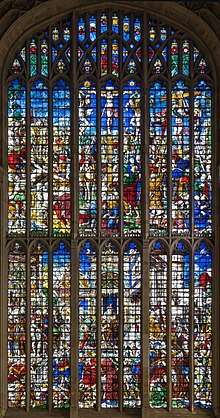
The windows of King's College Chapel are some of the finest in the world from their era. There are 12 large windows on each side of the Chapel, and larger windows at the east and west ends. With the exception of the west window, they are by Flemish hands and date from 1515 to 1531. Barnard Flower, the first non-Englishman appointed as the King's Glazier, completed four windows. Gaylon Hone and three partners (two English and one Flemish) are responsible for the east window and 16 others between 1526 and 1531. The final four were made by Francis Williamson and Symon Symondes. The one modern window is that in the west wall, which was donated by King's alumnus Francis Stacey and is by the Clayton and Bell company and dates from 1879.
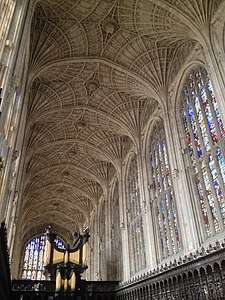
Rood screen
This large wooden screen, which separates the nave from the altar and supports the organ, was erected in 1532–36 by Henry VIII in celebration of his marriage to Anne Boleyn. The screen is an example of early Renaissance architecture: a striking contrast to the Perpendicular Gothic Chapel; Sir Nikolaus Pevsner said it is "the most exquisite piece of Italian decoration surviving in England".[17]
Current use
The Chapel is actively used as a place of worship and also for some concerts and college events. Notable college events include the annual King's College Music Society May Week Concert, held on the Monday of May Week. The event is popular with students, alumni, and visitors to the city.
The Chapel is noted for its splendid acoustics. The world-famous Choir of King's College, Cambridge consists of choral scholars, organ scholars (male students at the college), and choristers (boys educated at the nearby King's College School). From 1982 until shortly before his death on 22 November 2019 the director of music for the choir was Sir Stephen Cleobury. The choir sings services on most days in term-time, and also performs concerts and makes recordings and broadcasts.
The BBC has broadcast the Choir's Nine Lessons and Carols from the chapel on Christmas Eve, during which a solo treble sings the first verse of Once in Royal David's City. There is also a chapel choir of male and female students, King's Voices, which sings Evensong on Mondays during term-time.
The chapel is widely seen as a symbol of Cambridge (for example in the logo of Cambridge City Council).
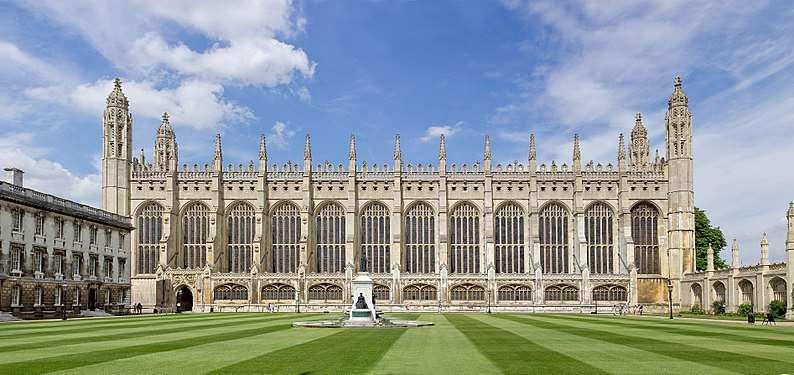 Side view of the Chapel from inside the college.
Side view of the Chapel from inside the college. King's College Chapel, Cambridge, South Entrance by Henry Fox Talbot, circa 1845
King's College Chapel, Cambridge, South Entrance by Henry Fox Talbot, circa 1845
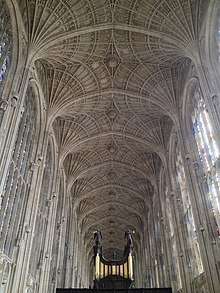
Dean of the Chapel
The Dean of the Chapel is responsible to the College Council and the Governing Body for the conduct of services within the Chapel. King's College Chapel, like other Cambridge colleges, is not formally part of the structure of the Church of England, but the Dean is customarily licensed by the Bishop of Ely. Both he and the Chaplain take a regular part in chapel services: each is normally present at services six days a week during Full Term, and each preaches once or twice a term. The Chapel is run by a Chapel Committee chaired by the Dean. A Use of Choirs Committee, also chaired by the Dean, organises the engagements of the Chapel choir.[18]
Recent deans
- 1918 to 1941 - The Revd Eric Milner-White
- 1942 to 1948 - The Revd Rollo Graham Campbell
- 1949 to 1956 - The Very Revd Ivor Ramsay
- 1956 to 1966 - The Revd Dr. Alexander Vidler
- 1966 to 1970 - The Revd David Edwards
- 1970 to 1980 - The Revd Michael Till[19]
- 1981 to 1991 - The Revd Canon John Drury[20]
- 1991 to 2001 - The Revd George Pattison
- 2002 to 2004 - The Revd Christopher Ryan[21]
- 2005 to 2009 - The Revd Ian Thompson[22]
- 2010 to 2014 - The Revd Jeremy Morris
- 2014 to present - The Revd Stephen Cherry[23]
Bibliography
- Warrior, Josephine. A Guide to King's College Chapel. Photography and design by Tim Rawle (Cambridge 1994, reprinted 1997, 2001, 2003, 2007, 2014)
References
- "KING'S COLLEGE, CHAPEL". Historic England.
- Alison Stones, Images of Medieval Art and Architecture — Britain: England, Cambridge (King's College Chapel).
- Saltmarsh, John: King's College (in Victoria County History of Cambridgeshire, Volume III, ed. J.P.C. Roach, 1959)
- "Visit Cambridge". Archived from the original on 4 April 2013. Retrieved 20 November 2012.
- Cambridge City Council Archived 7 November 2012 at the Wayback Machine
- Curl, James Stevens; Wilson, Susan, eds. (2015), "Ely, Reginald", A Dictionary of Architecture and Landscape Architecture (3rd ed.), Oxford University Press, doi:10.1093/acref/9780199674985.001.0001/acref-9780199674985-e-1660, ISBN 978-0-19-967498-5, retrieved 17 May 2020
- Thomas John P. Carter, King's college chapel: notes on its history and present condition (Macmillan and Co, 1867), 10
- Horace Walpole (1937). The Yale Edition of Horace Walpole's Correspondence, Volume 1. Yale University Press. p. 18.
- Frederick Mackenzie (1840). Observations on the Construction of the Roof of King's College Chapel, Cambridge.
- A Century of King's, 1873–1972 by L.P. Wilkinson, 1980: 130–131
- Chainey, Graham (1994). "The East End of King's College Chapel". Proceedings of the Cambridge Antiquarian Society. LXXXIII: 141–168.
- GRAHAM, CHAINEY. "A season for crying in the chapel: Millions will enjoy today's festival of carols from King's College, Cambridge. But Graham Chainey mourns a botched 'restoration'". The Independent. Retrieved 14 March 2017.
- Plommer, Hugh (12 June 1965). Cambridge Review. Missing or empty
|title=(help) - Wilkinson, L. P. (1980). A Century of King's. Cambridge. pp. 130–131.
- "Obituary: Sir Martyn Beckett, Bt". The Daily Telegraph. 6 August 2001. Retrieved 2 September 2019.
- King's College Chapel, Cambridge at britainexpress.com
- Pevsner, An Outline of European architecture 1963:292f.
- "Job vacancies » Dean of Chapel". King's College, Cambridge. 2014. Archived from the original on 20 April 2014. Retrieved 12 June 2014.
- "The Very Reverend Michael Till". 2013. ISSN 0307-1235. Retrieved 12 January 2018.
- "The Very Revd Dr John Drury". All Souls College. University of Oxford. Retrieved 11 February 2016.
- Kirkpatrick, Robin (2 March 2004). "The Rev C. J. Ryan". The Independent. Retrieved 11 February 2016.
- Johnston, Ian; Lefort, Rebecca (26 September 2009). "Cambridge theologian Rev Ian Thompson found dead amid allegations of 'indecency'". The Daily Telegraph. Retrieved 11 February 2016.
- "New Dean of King's". King's College, Cambridge. 29 April 2014. Retrieved 11 February 2016.
External links
| Wikimedia Commons has media related to King's College Chapel, Cambridge. |
